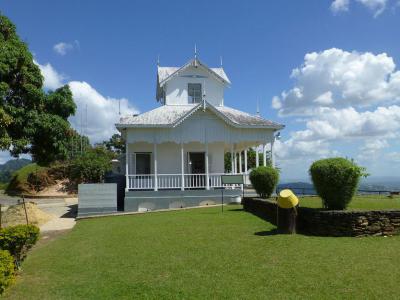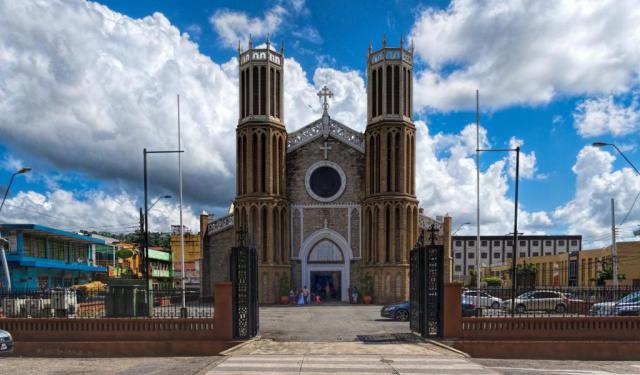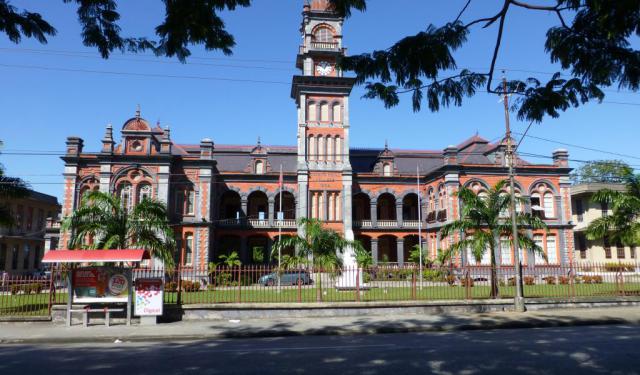
Fort George, Port of Spain
Fort George is a former British fort in the Trinidadian capital of Port of Spain that now serves as a museum.
In early 1803, the British colonial administration under Governor Sir Thomas Hislop began strengthening Trinidad's defenses against potential attack. The part of the island of Chaguarama north-west of the capital was initially selected as the starting point. There, construction of an infantry post on the Point Gourde peninsula and construction of a naval base in Chaguaramas Bay began. At the end of 1803, Hislop changed his mind and now favored the current location of the fort for an expansion, where several cannons were already located, covering the Gulf of Paria off Port of Spain.
Since the financing of such construction projects was the responsibility of the British Crown and, along with Hislop, several institutions had a say in such matters, there was a dispute between Hislop and the commander of the British West Indies forces in Barbados, Lieutenant General William Myers, who felt ignored and called for the further construction of Point Gourde ordered. Hislop resisted, contacted the British government, for which a secretary of state tried unsuccessfully to mediate, and ultimately prevailed by sending senior Trinidadian dignitaries on a diplomatic mission to see Myers, who eventually relented.
The place where the fort was built was originally called La Vigie (English: Lookout), named by French settlers admitted under the 1783 Cedula de populacion. In 1805, Hislop built the fort at this strategic location, then called Fort Vigie, to defend the island's capital, Port of Spain, against sea attacks. It was built by African slaves led by Jonas Mohammed Bath, leader of the local Mandinka community and alleged Sultan of Yulliallhad Alimant. A little later, it was renamed in honor of the then British King George III. Although Trinidad was subsequently subjected to frequent attacks, and although Fort George replaced the older Fort San Andres as it was intended to increase Port of Spain's defences, not a shot was ever fired from the fort's cannons. Military use ended in 1846.
In 1883 a Victorian style house was built on the site of the fort to serve as a signal station. From the building, flag signals were received from the North Post Wireless Station to the west and relayed to the harbor master's quarters in Port of Spain to the south-east. The content of the flag signals were ship movements in the Caribbean Sea, which could be observed from the North Post Wireless Station. The signal station was designed and built by Kofi Nti, son of the Ashanti king Kofi Calcali, who came to Trinidad after the third Ashanti war.
Restoration of the fort began in 1965. The beacon house was converted into a museum depicting the history of the fort. Several cannons from the early 19th century survive. Due to its exposed location, the fort forms a tourist vantage point from which one can see Port of Spain, the Caroni Swamp behind it, as well as the northern suburbs of Port of Spain and the Chaguaramas offshore islands.
In Hislop's time, the fort was flanked by five external gun groups: Below the fort were the gun groups York, Princess Charlotte, Abercromby (which was the first to be built) and Cambridge, and above the fort was the Cumberland gun group. Inside the facility is a prison cell, consisting of a parallelepiped-shaped room dug into the hill, the entrance to which is barred with a lattice made of old gun barrels. Despite being designed as a prison, this cell was never held prisoner, instead serving as a place for merchants and plantation owners to store valuables in troubled times.
In early 1803, the British colonial administration under Governor Sir Thomas Hislop began strengthening Trinidad's defenses against potential attack. The part of the island of Chaguarama north-west of the capital was initially selected as the starting point. There, construction of an infantry post on the Point Gourde peninsula and construction of a naval base in Chaguaramas Bay began. At the end of 1803, Hislop changed his mind and now favored the current location of the fort for an expansion, where several cannons were already located, covering the Gulf of Paria off Port of Spain.
Since the financing of such construction projects was the responsibility of the British Crown and, along with Hislop, several institutions had a say in such matters, there was a dispute between Hislop and the commander of the British West Indies forces in Barbados, Lieutenant General William Myers, who felt ignored and called for the further construction of Point Gourde ordered. Hislop resisted, contacted the British government, for which a secretary of state tried unsuccessfully to mediate, and ultimately prevailed by sending senior Trinidadian dignitaries on a diplomatic mission to see Myers, who eventually relented.
The place where the fort was built was originally called La Vigie (English: Lookout), named by French settlers admitted under the 1783 Cedula de populacion. In 1805, Hislop built the fort at this strategic location, then called Fort Vigie, to defend the island's capital, Port of Spain, against sea attacks. It was built by African slaves led by Jonas Mohammed Bath, leader of the local Mandinka community and alleged Sultan of Yulliallhad Alimant. A little later, it was renamed in honor of the then British King George III. Although Trinidad was subsequently subjected to frequent attacks, and although Fort George replaced the older Fort San Andres as it was intended to increase Port of Spain's defences, not a shot was ever fired from the fort's cannons. Military use ended in 1846.
In 1883 a Victorian style house was built on the site of the fort to serve as a signal station. From the building, flag signals were received from the North Post Wireless Station to the west and relayed to the harbor master's quarters in Port of Spain to the south-east. The content of the flag signals were ship movements in the Caribbean Sea, which could be observed from the North Post Wireless Station. The signal station was designed and built by Kofi Nti, son of the Ashanti king Kofi Calcali, who came to Trinidad after the third Ashanti war.
Restoration of the fort began in 1965. The beacon house was converted into a museum depicting the history of the fort. Several cannons from the early 19th century survive. Due to its exposed location, the fort forms a tourist vantage point from which one can see Port of Spain, the Caroni Swamp behind it, as well as the northern suburbs of Port of Spain and the Chaguaramas offshore islands.
In Hislop's time, the fort was flanked by five external gun groups: Below the fort were the gun groups York, Princess Charlotte, Abercromby (which was the first to be built) and Cambridge, and above the fort was the Cumberland gun group. Inside the facility is a prison cell, consisting of a parallelepiped-shaped room dug into the hill, the entrance to which is barred with a lattice made of old gun barrels. Despite being designed as a prison, this cell was never held prisoner, instead serving as a place for merchants and plantation owners to store valuables in troubled times.
Sight description based on Wikipedia.
Want to visit this sight? Check out these Self-Guided Walking Tours in Port of Spain. Alternatively, you can download the mobile app "GPSmyCity: Walks in 1K+ Cities" from Apple App Store or Google Play Store. The app turns your mobile device to a personal tour guide and it works offline, so no data plan is needed when traveling abroad.
Fort George on Map
Sight Name: Fort George
Sight Location: Port of Spain, Trinidad and Tobago (See walking tours in Port of Spain)
Sight Type: Attraction/Landmark
Sight Location: Port of Spain, Trinidad and Tobago (See walking tours in Port of Spain)
Sight Type: Attraction/Landmark
Walking Tours in Port of Spain, Trinidad and Tobago
Create Your Own Walk in Port of Spain
Creating your own self-guided walk in Port of Spain is easy and fun. Choose the city attractions that you want to see and a walk route map will be created just for you. You can even set your hotel as the start point of the walk.
Port of Spain Introduction Walk
Port of Spain was once the site of a fishing village of Amerindian people. It was called "Place of the silk cotton trees." By 1560, a Spanish garrison was stationed in the area. By 1757, the village had changed to the capital of the Port of Spain.
The last Spanish governor of Trinidad, Don Jose Chacon, opened the colony to French Catholic immigrants. The population grew and the town... view more
Tour Duration: 1 Hour(s)
Travel Distance: 1.7 Km or 1.1 Miles
The last Spanish governor of Trinidad, Don Jose Chacon, opened the colony to French Catholic immigrants. The population grew and the town... view more
Tour Duration: 1 Hour(s)
Travel Distance: 1.7 Km or 1.1 Miles
Historic Buildings Walking Tour
A group of mansions in northern Port of Spain, located on Maraval Road, to the west of the Queen's Park Savannah, is known colloquially as “The Magnificent Seven”. They were built between 1902 and 1910 on the land that was previously used as a government stock farm. Together with the nearby President's House, the official residence of the President of Trinidad and Tobago, which is... view more
Tour Duration: 1 Hour(s)
Travel Distance: 1.1 Km or 0.7 Miles
Tour Duration: 1 Hour(s)
Travel Distance: 1.1 Km or 0.7 Miles


